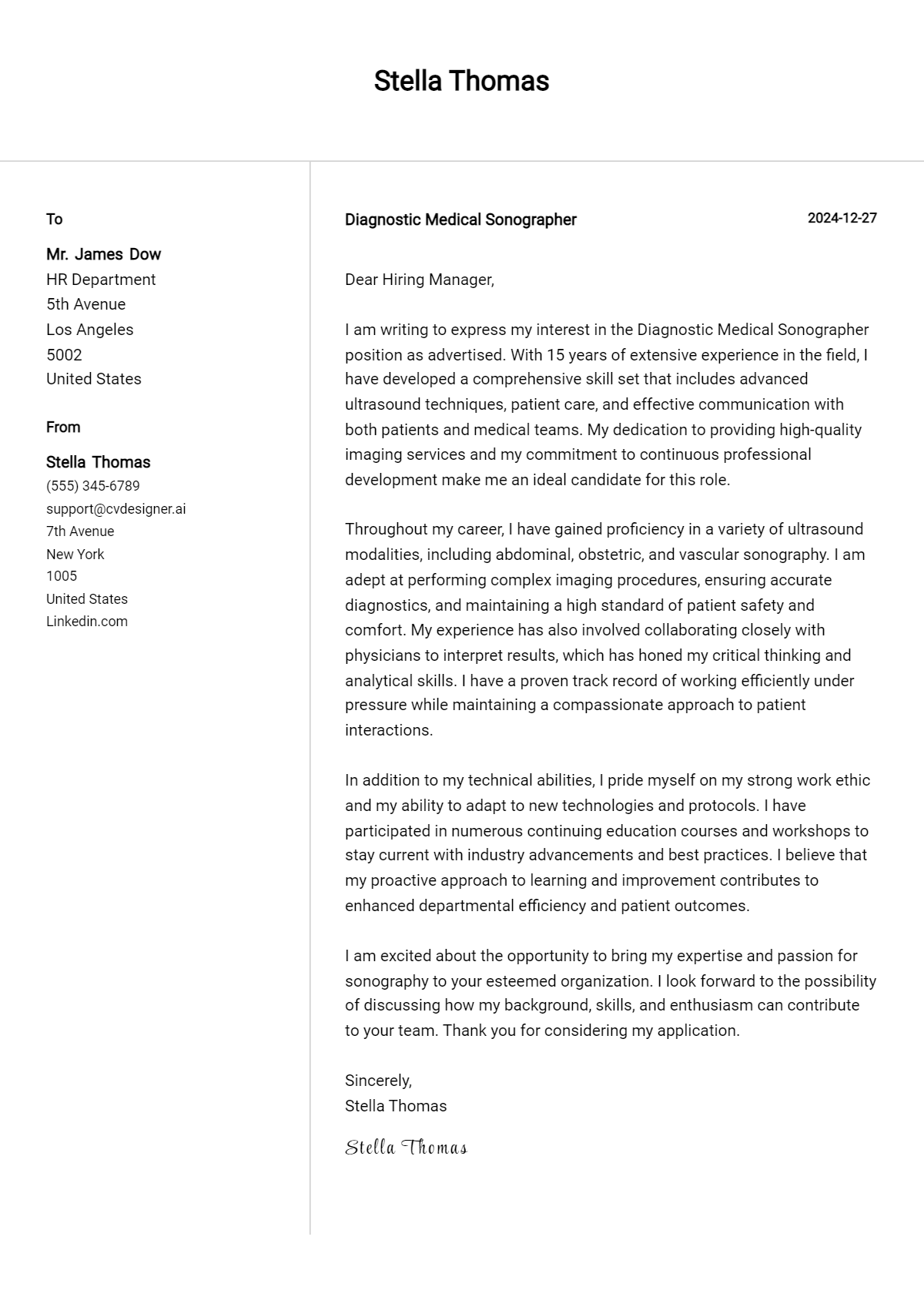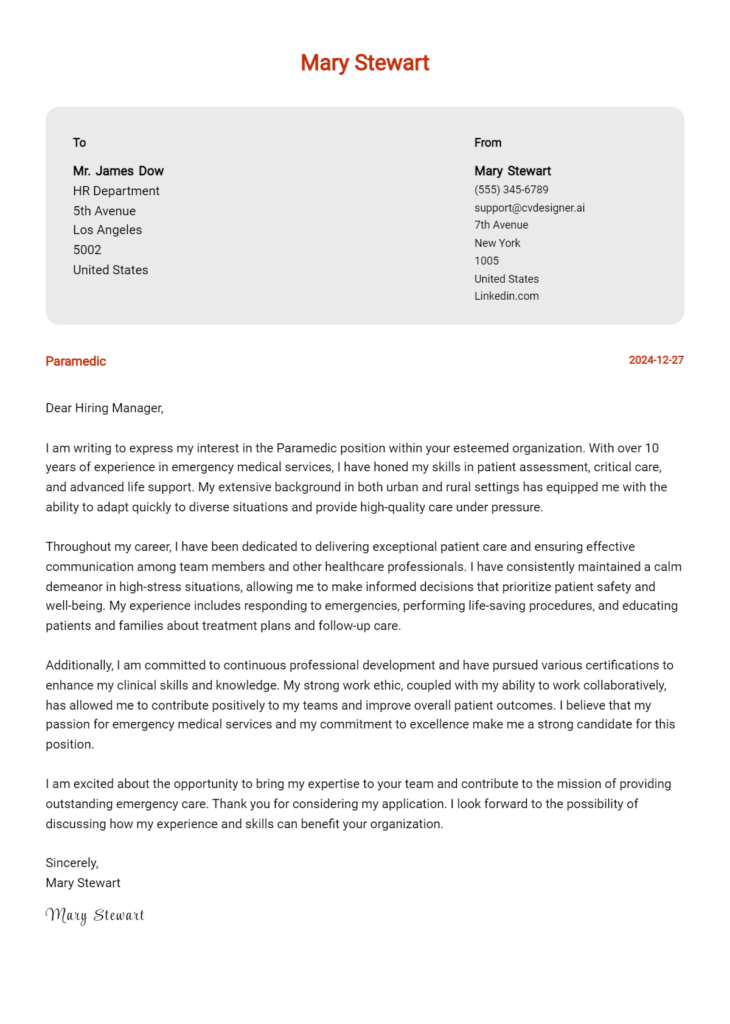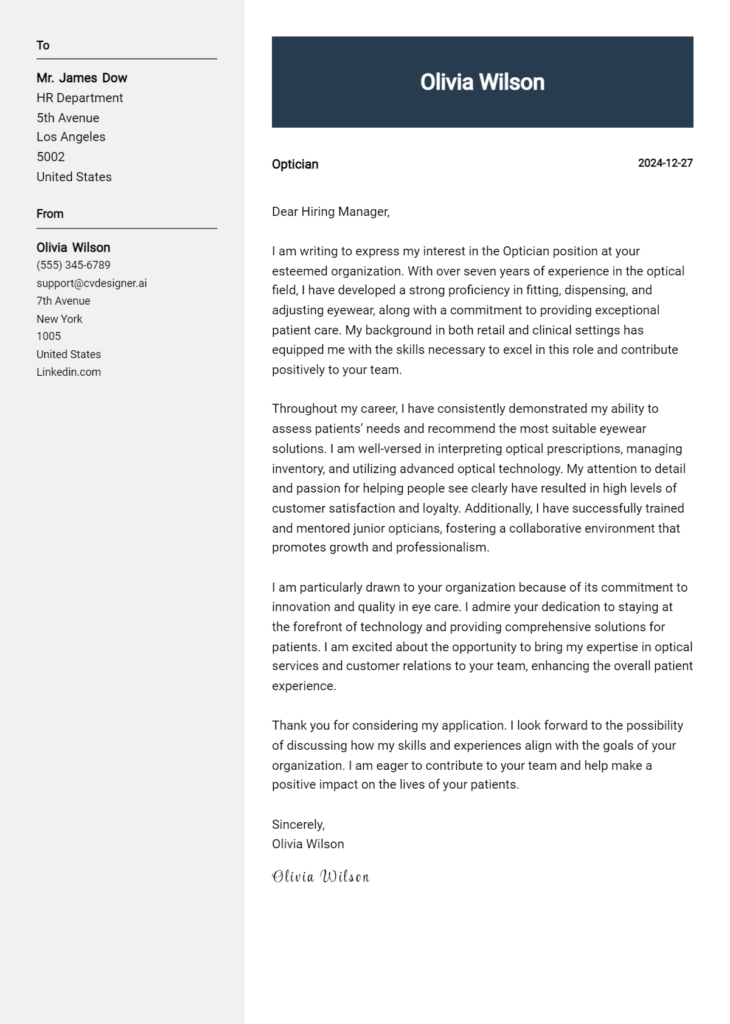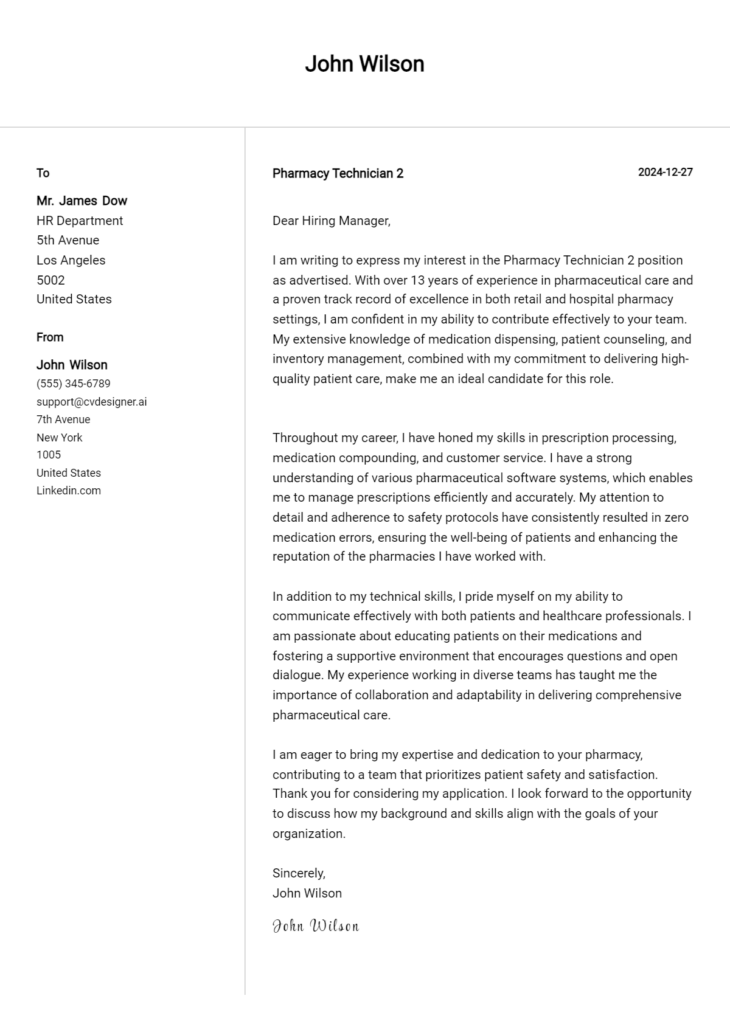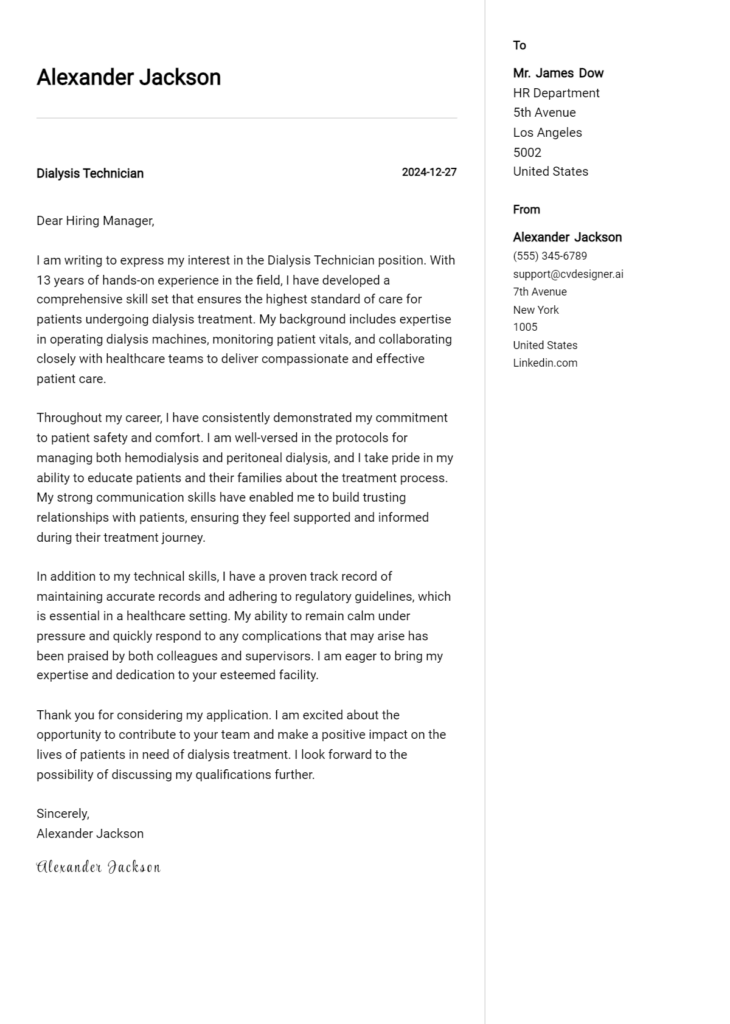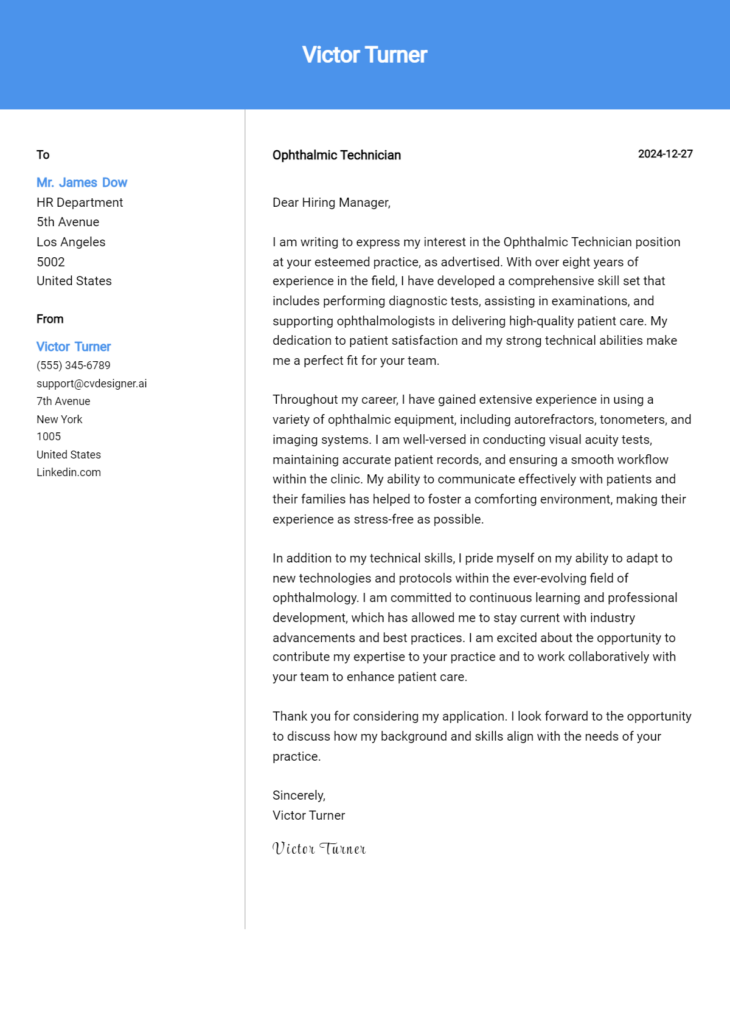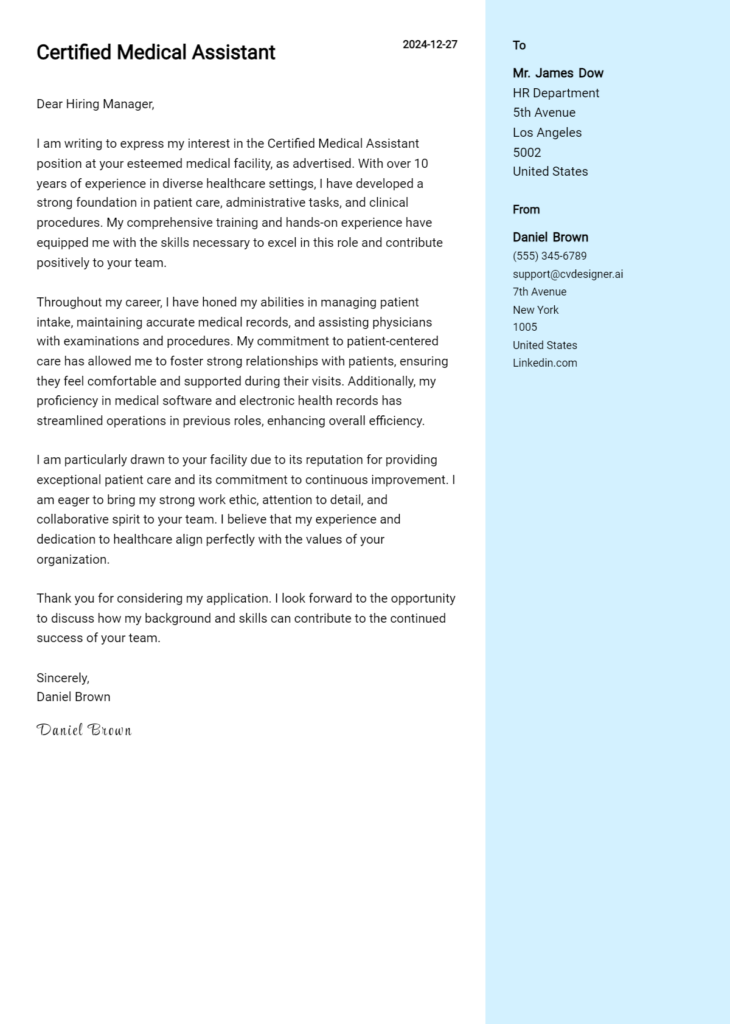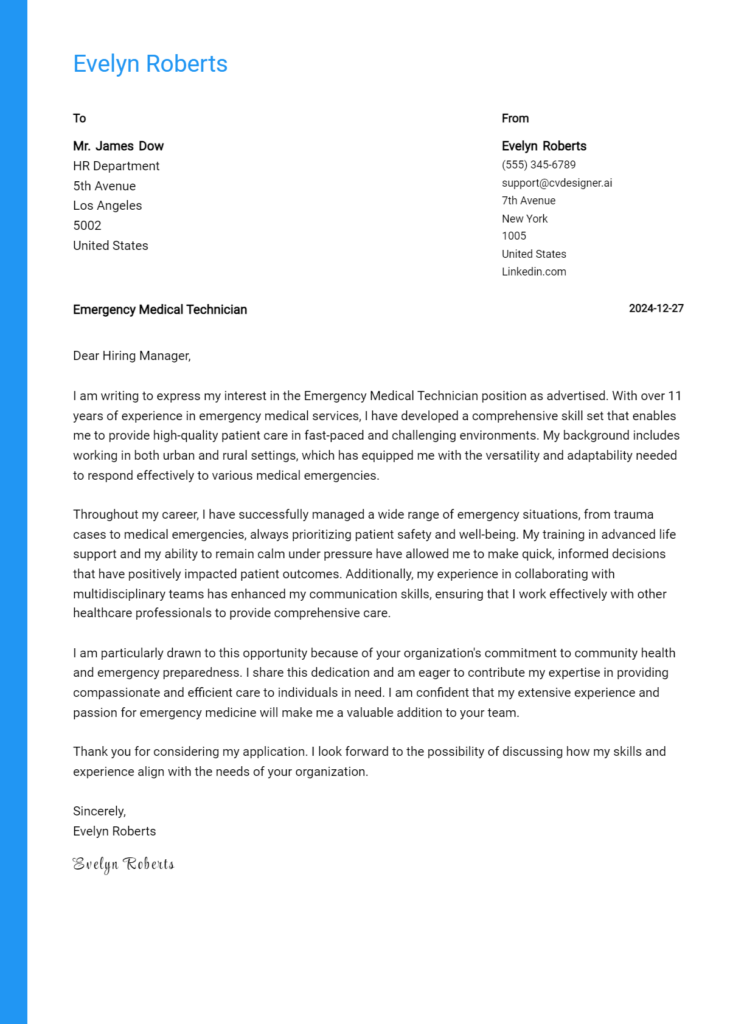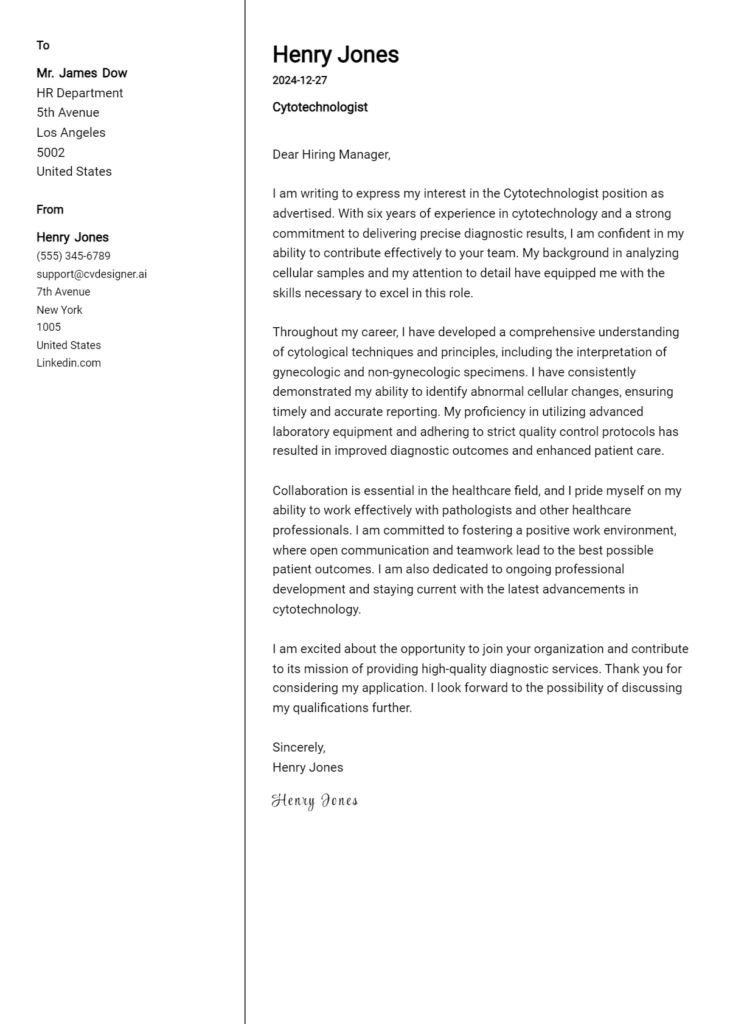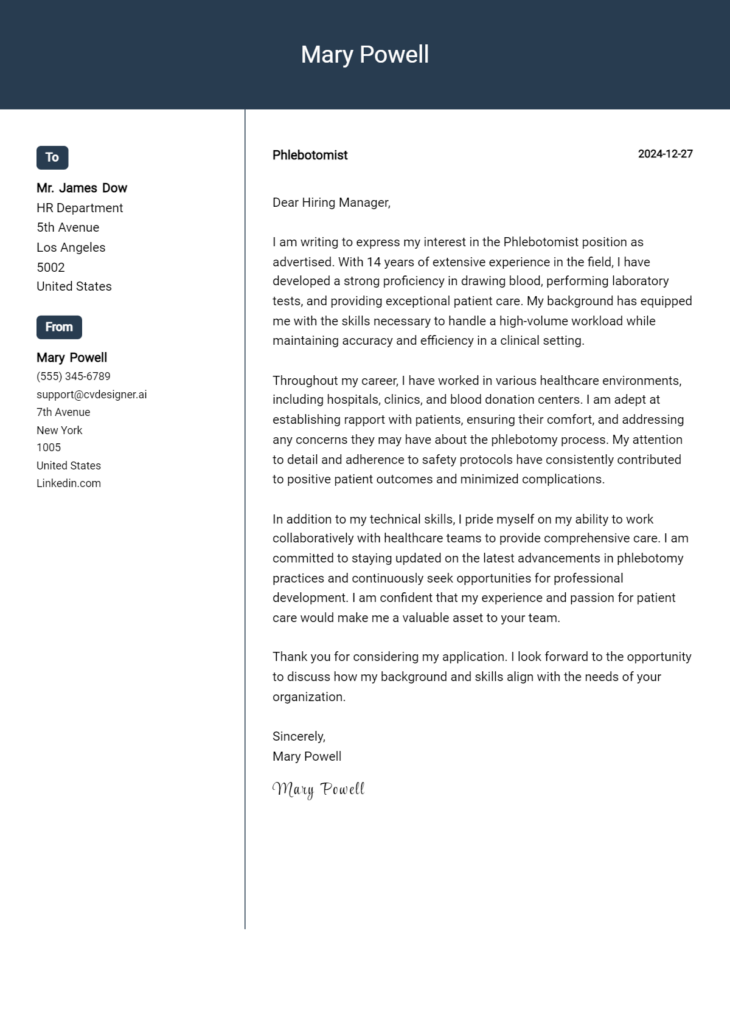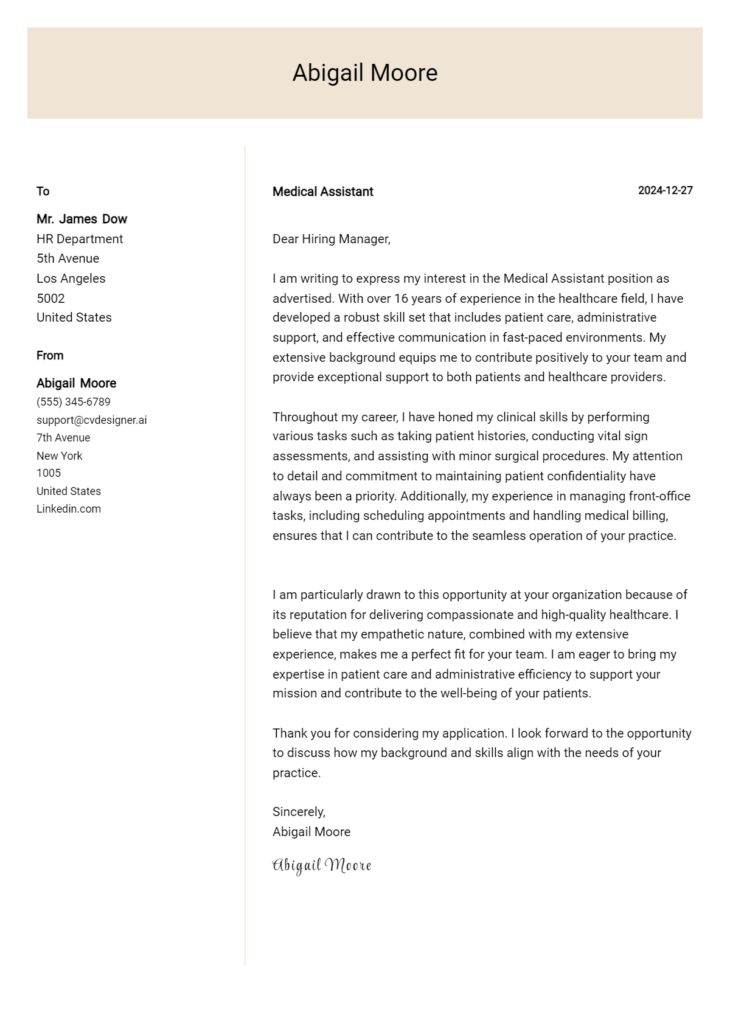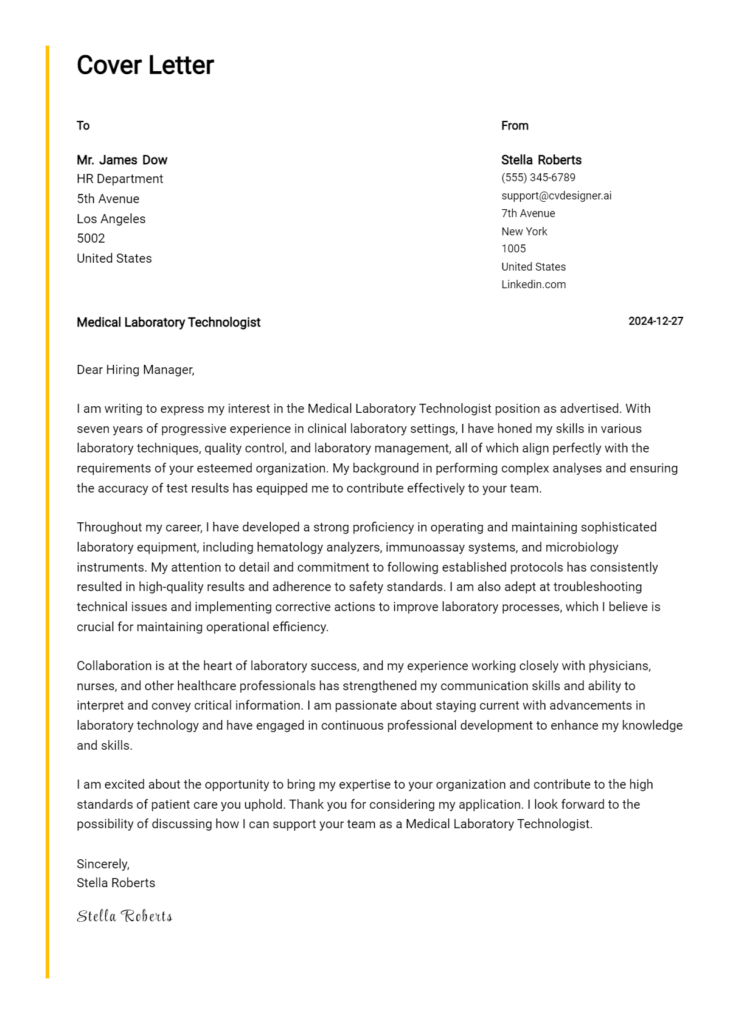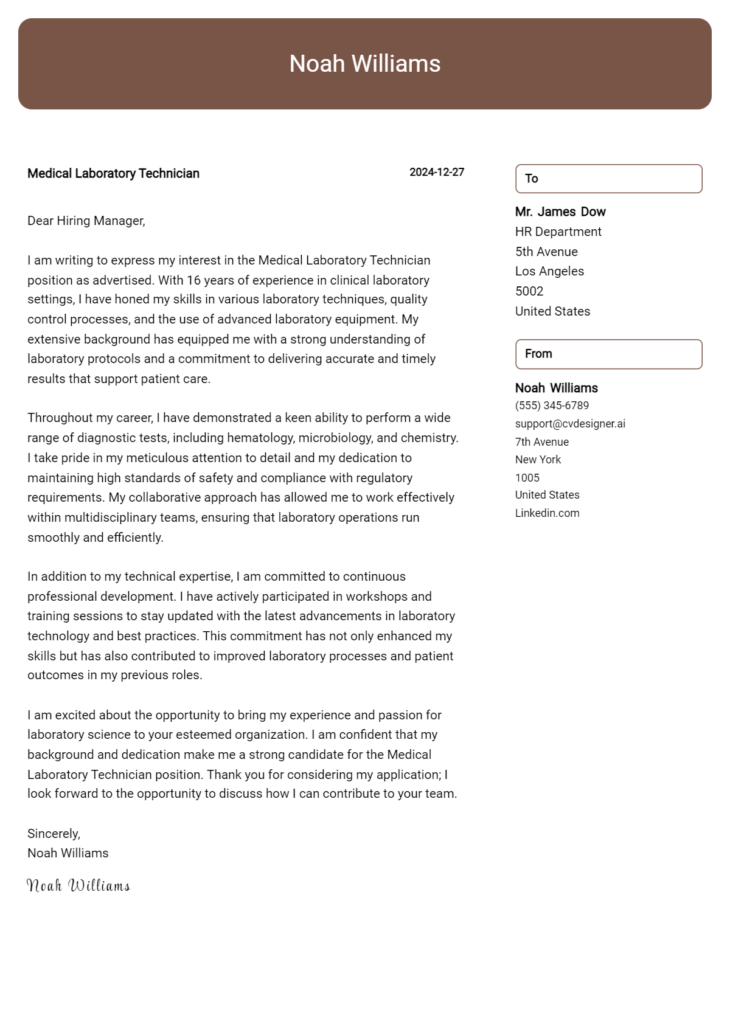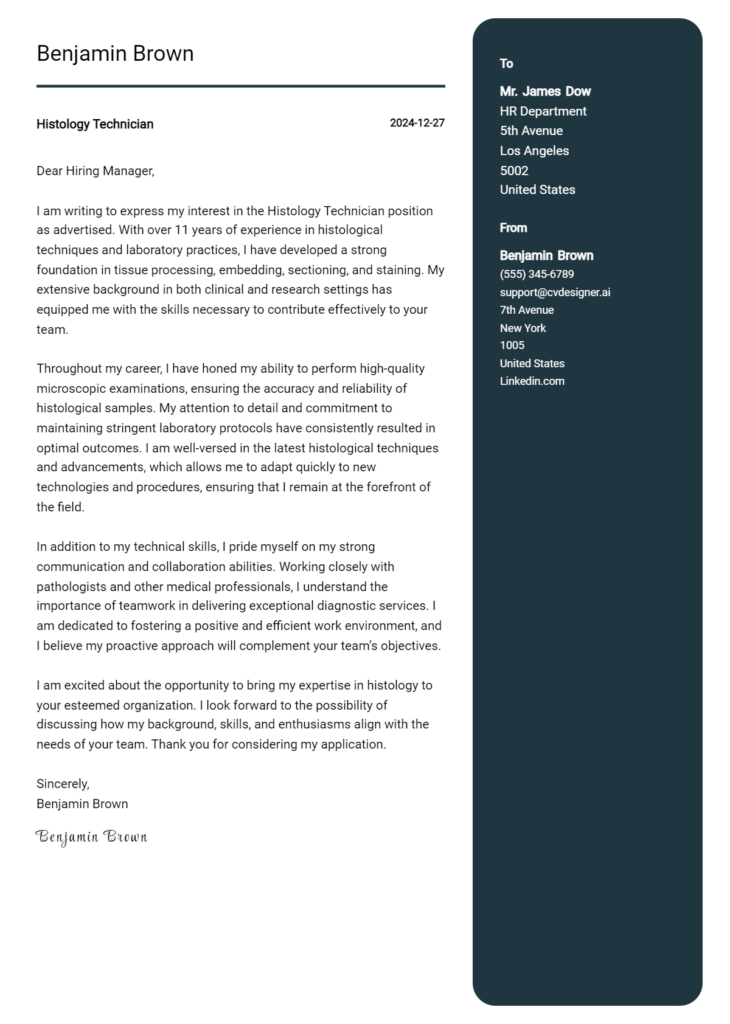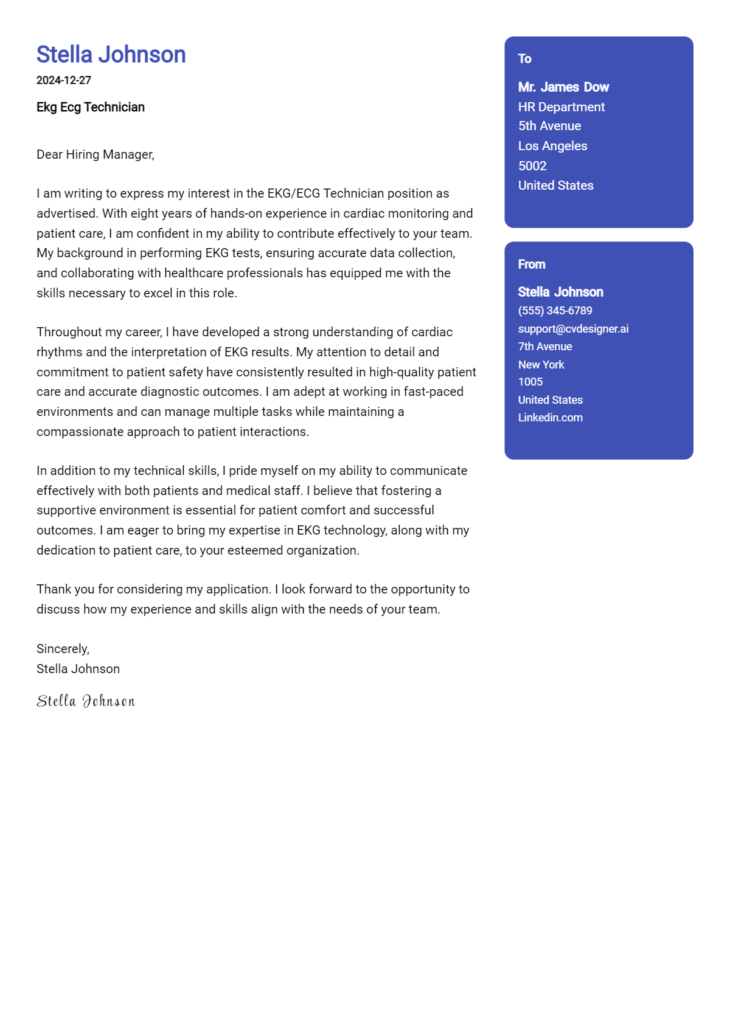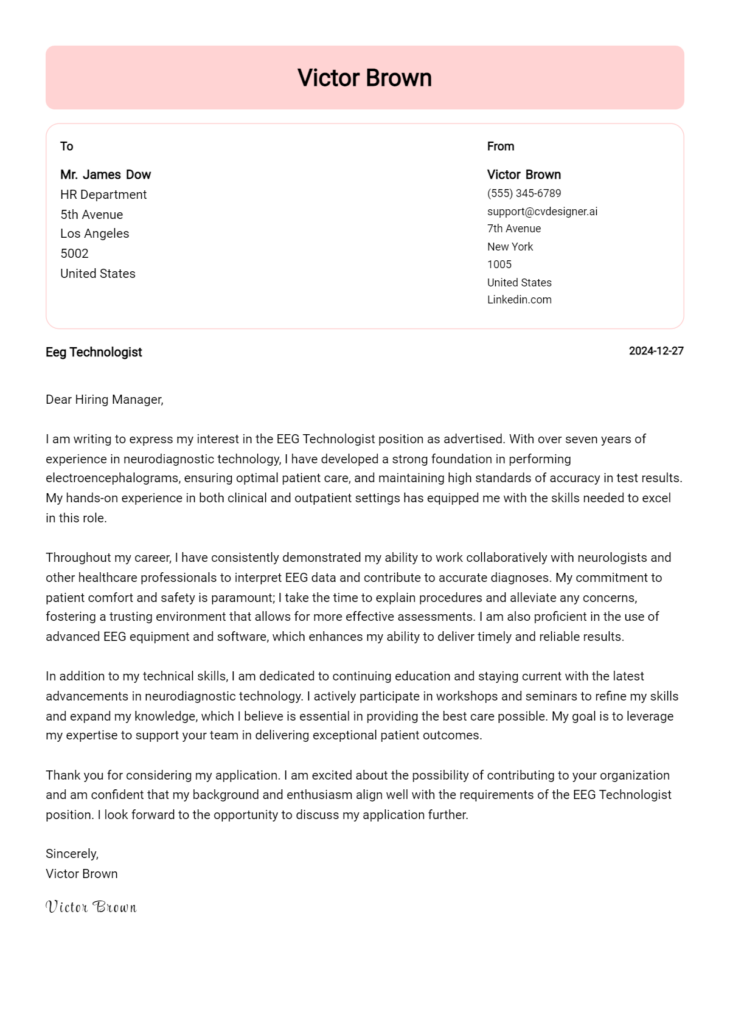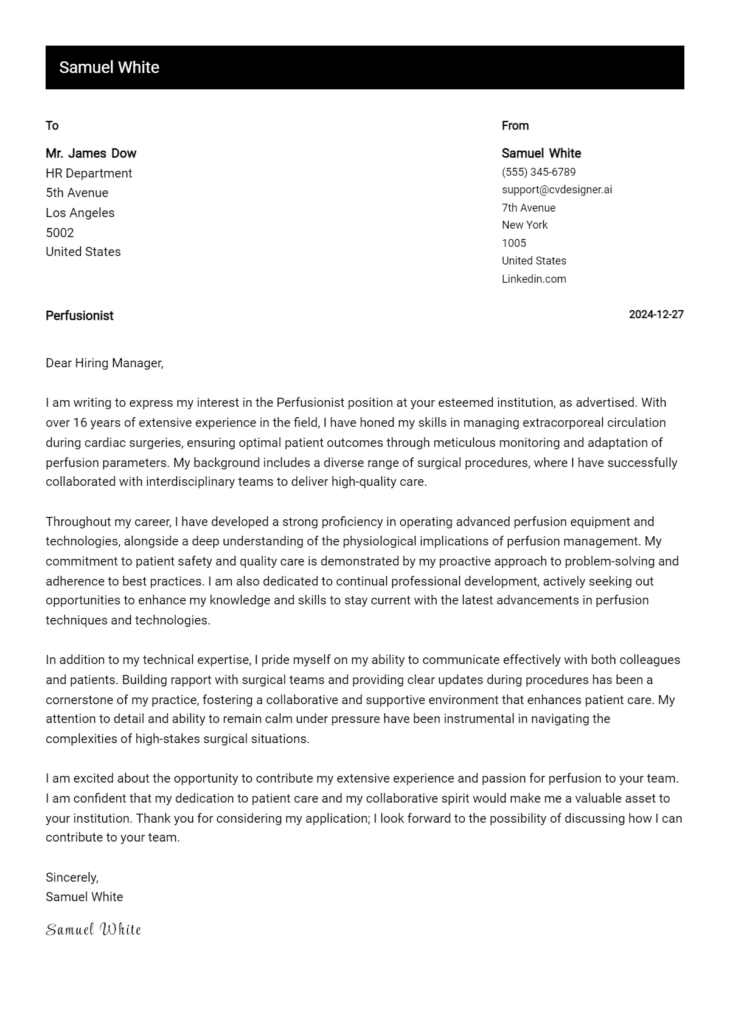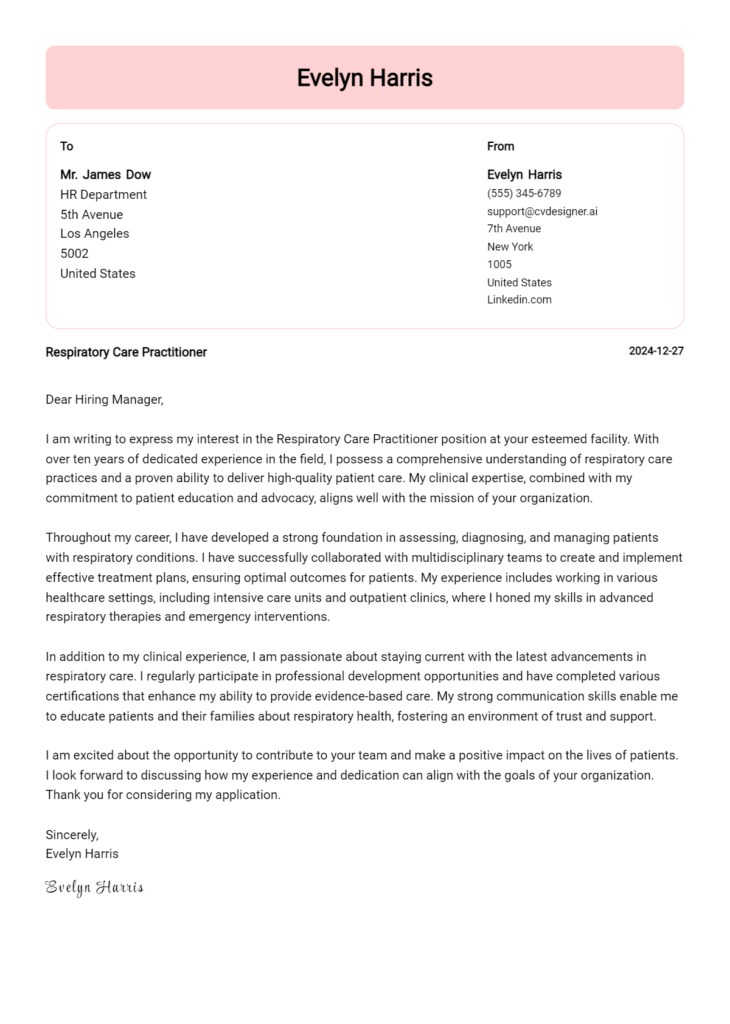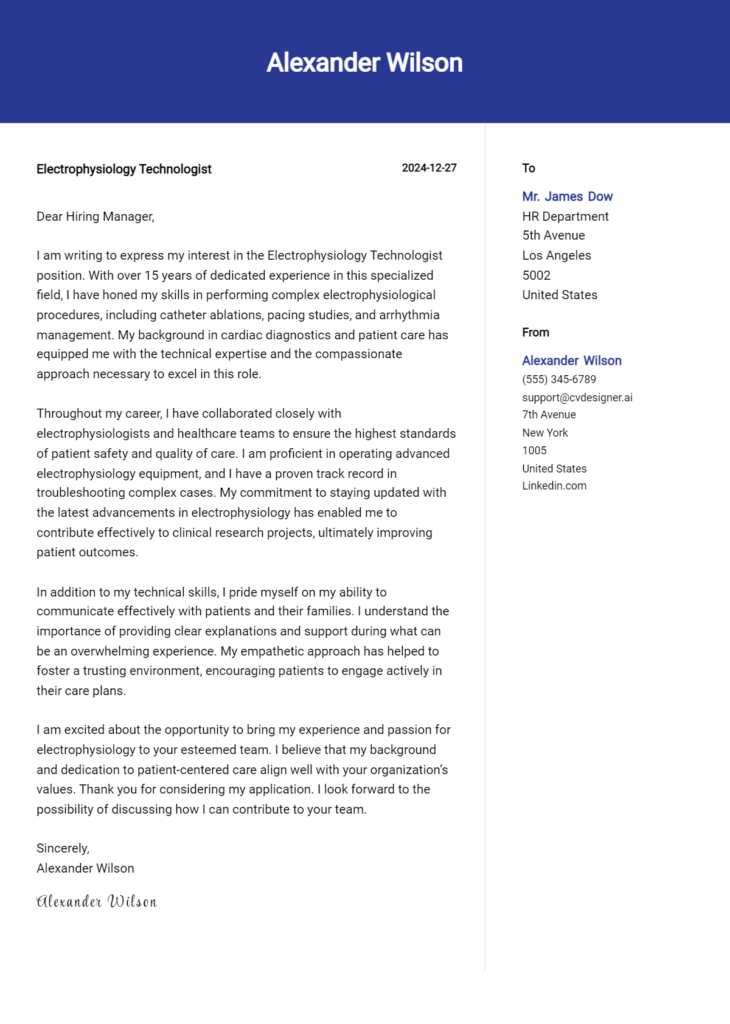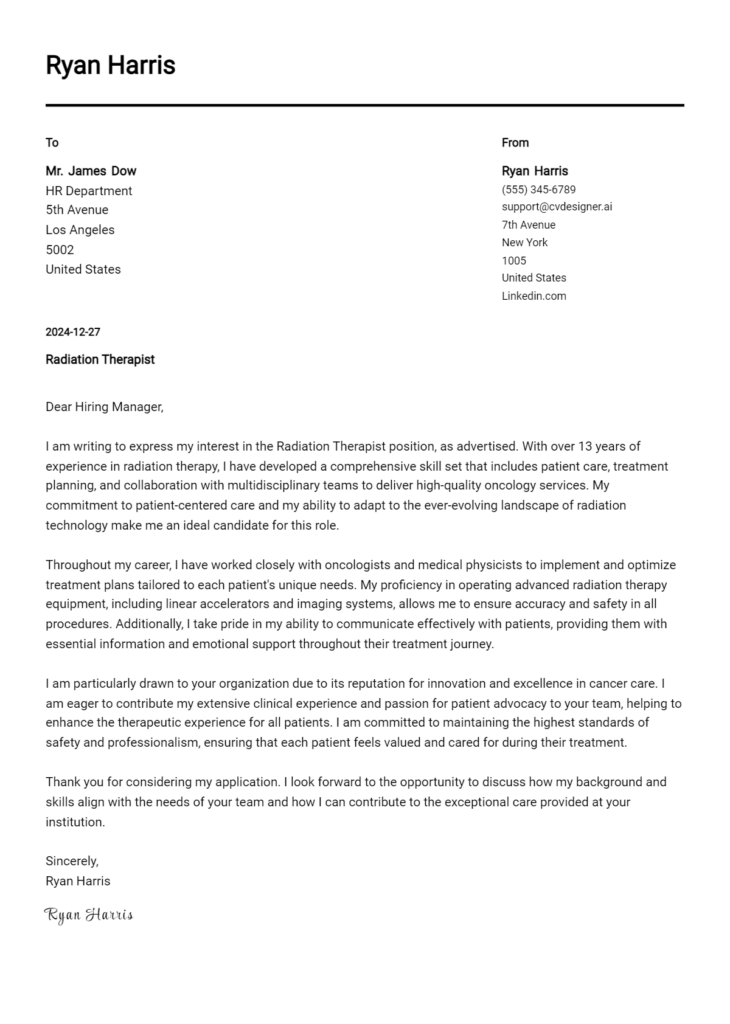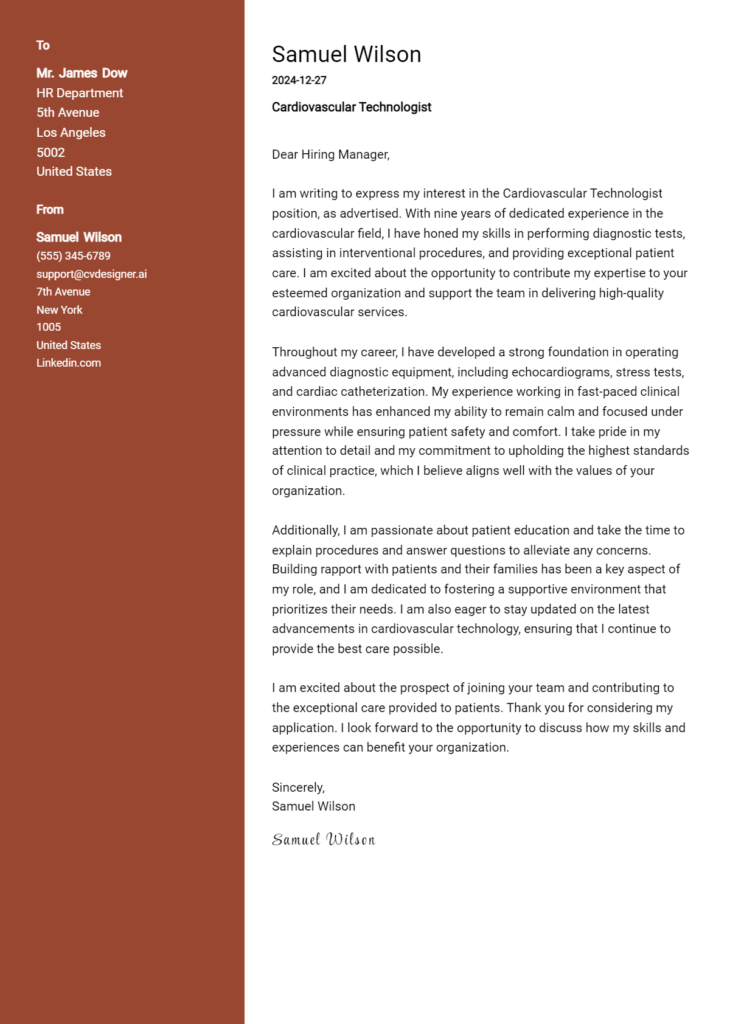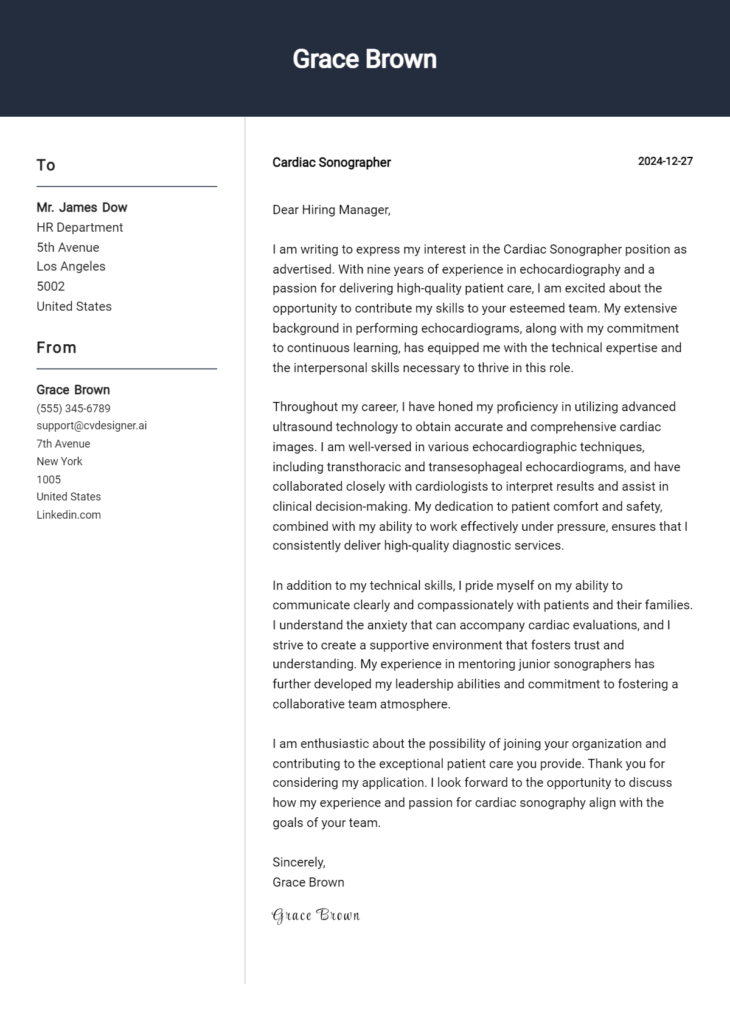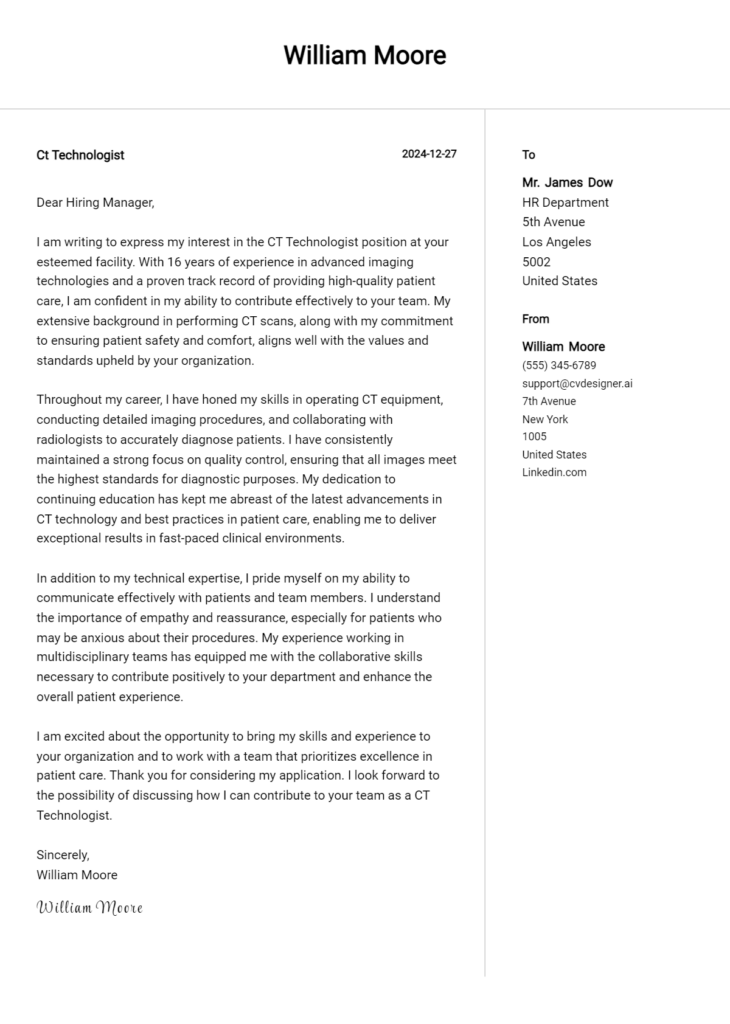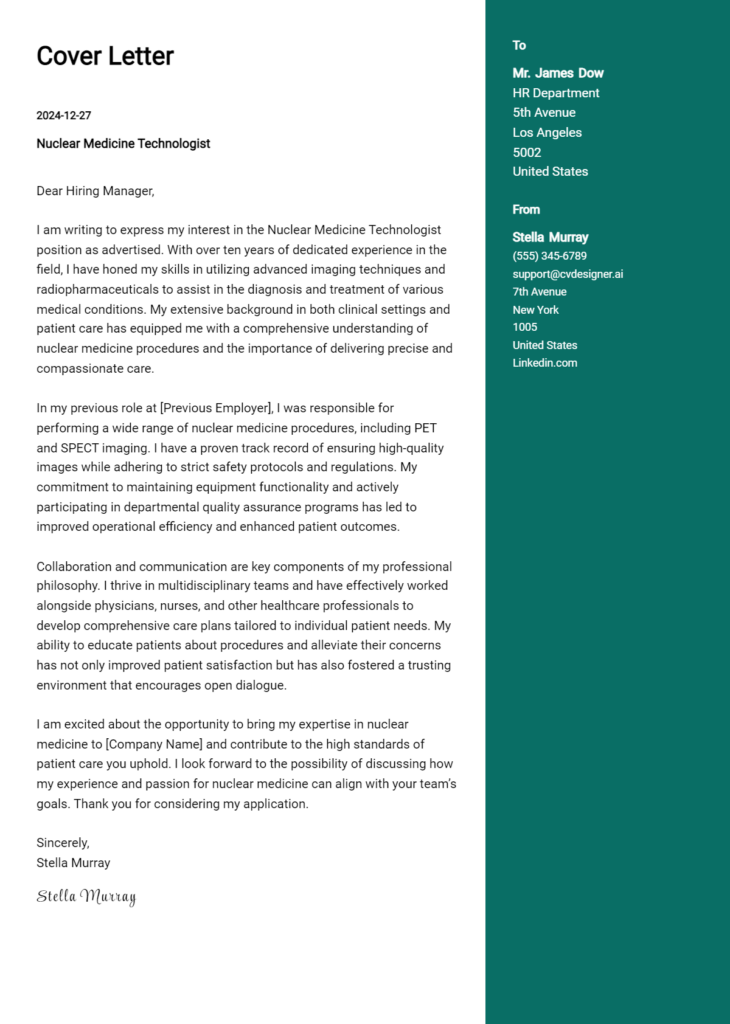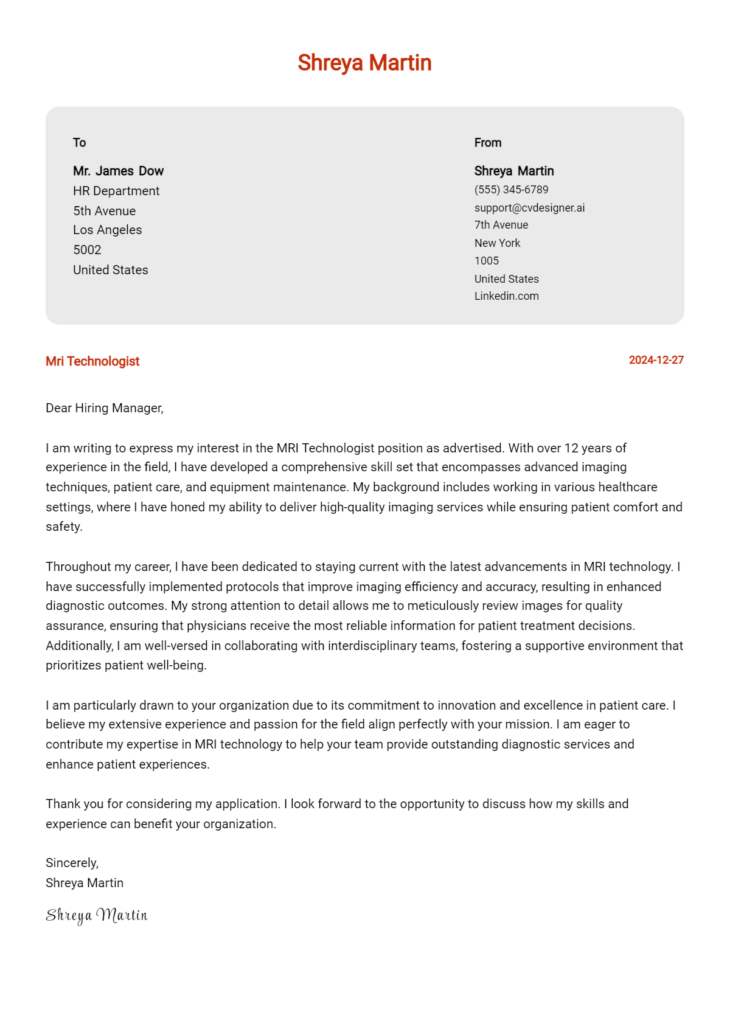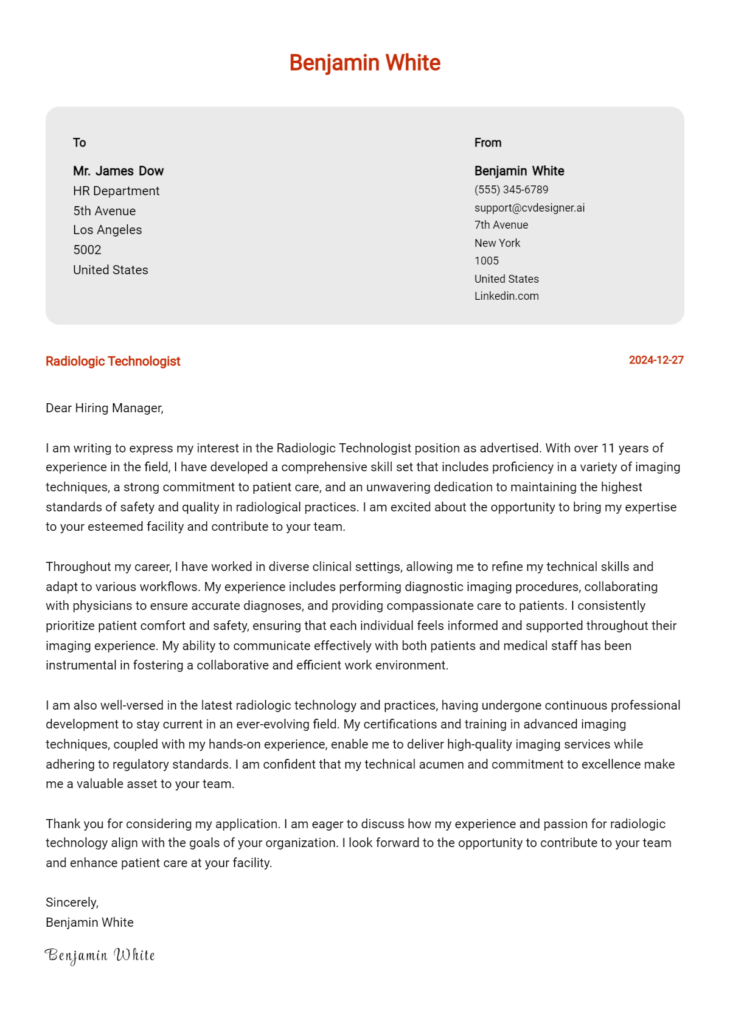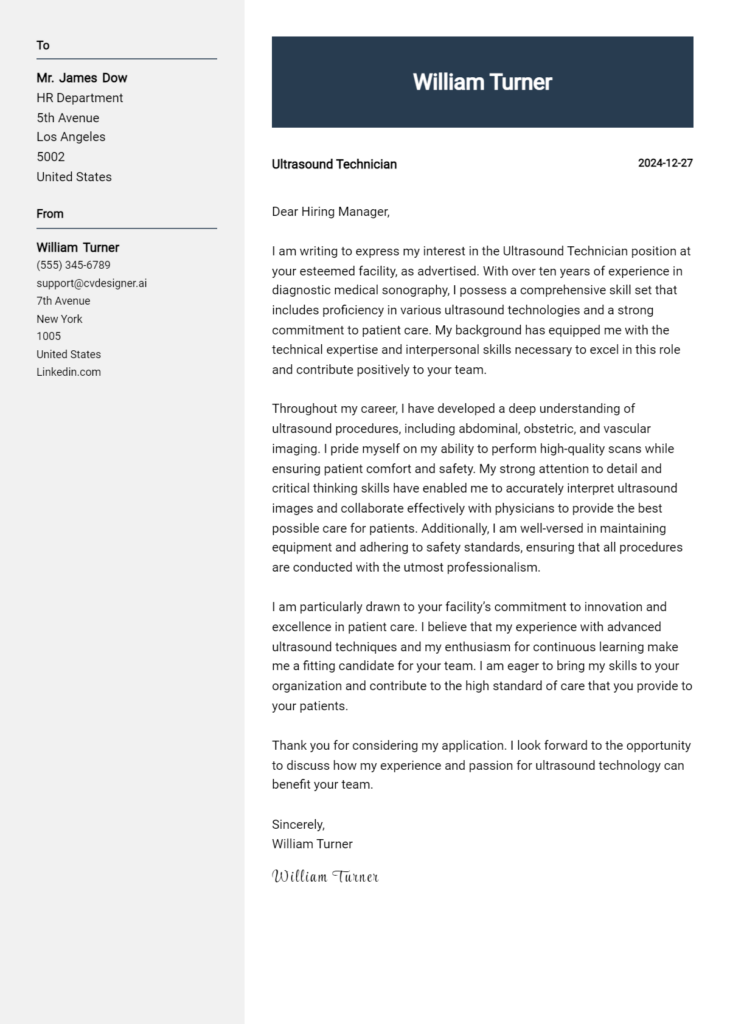Diagnostic Medical Sonographer Cover Letter Examples
Explore additional Diagnostic Medical Sonographer cover letter samples and guides and see what works for your level of experience or role.
How to Format a Diagnostic Medical Sonographer Cover Letter?
Crafting a compelling cover letter is essential for a Diagnostic Medical Sonographer, as it serves as your first opportunity to make a positive impression on potential employers. The way you format your cover letter not only reflects your professionalism but also demonstrates your attention to detail—critical traits in the medical imaging field. A well-structured cover letter can effectively highlight your qualifications, experience, and passion for patient care while making it easier for hiring managers to see why you would be a valuable addition to their team.
In this guide, we will outline the key components of a professional cover letter that will help you stand out in your job search, including:
- Cover Letter Header
- Cover Letter Greeting
- Cover Letter Introduction
- Cover Letter Body
- Cover Letter Closing
Each section plays a crucial role in presenting your skills and expertise. Let’s explore how to format each part to create a standout cover letter tailored for a Diagnostic Medical Sonographer position.
The Importance of a Cover Letter Header for a Diagnostic Medical Sonographer
A well-crafted cover letter header is essential for a Diagnostic Medical Sonographer, as it sets the tone for the entire document and establishes professionalism. The header should include your contact information, the date, and the recipient's details, all clearly formatted to ensure easy readability. Clarity in the header reflects your attention to detail—an important quality in the medical field. A strong header not only provides essential information but also creates a positive first impression for potential employers.
Strong Example
Jane Doe 123 Main Street Springfield, IL 62701 (555) 123-4567 jane.doe@email.com October 1, 2023 Mr. John Smith Hiring Manager XYZ Medical Center 456 Healthcare Blvd Springfield, IL 62702
Weak Example
jane doe october 1, 2023 xyz medical center 456 healthcare blvd
The Importance of a Strong Cover Letter Greeting
The greeting of a cover letter is a critical component that sets the tone for the entire document. A well-crafted greeting not only establishes a sense of professionalism but also personalizes the letter, making it more engaging for the hiring manager. By addressing the recipient directly, you demonstrate your attention to detail and genuine interest in the position. Avoiding generic greetings is essential; they can make your application feel impersonal and less compelling. Taking the time to research the hiring manager's name, if available, can significantly enhance the impact of your greeting.
Strong Greeting Example
Dear Mr. Smith,
Weak Greeting Example
To Whom It May Concern,
By using a strong greeting, you can create a positive first impression that encourages the reader to continue engaging with your letter.
The Importance of a Captivating Cover Letter Introduction for a Diagnostic Medical Sonographer
A well-crafted cover letter introduction is crucial for any job application, especially for a specialized role like a Diagnostic Medical Sonographer. This opening paragraph serves as your first impression, making it essential to not only capture the hiring manager's attention but also to convey your genuine interest in the position. An effective introduction should briefly highlight your relevant skills and achievements, setting the tone for the rest of the letter. Below are examples of both a strong and weak introduction to illustrate how to effectively engage the reader.
Strong Example
Dear Hiring Manager, As a passionate and detail-oriented Diagnostic Medical Sonographer with over five years of experience in delivering high-quality imaging services, I am excited to apply for the position at [Company Name]. My commitment to patient care and my proficiency in advanced sonographic techniques, including 3D imaging and Doppler ultrasound, have consistently contributed to accurate diagnoses and enhanced patient outcomes. I am eager to bring my expertise and dedication to your esteemed team.
Weak Example
To whom it may concern, I am writing to apply for the job of Diagnostic Medical Sonographer. I have some experience in this field and I think I could do a good job. I hope you consider my application.
Purpose of the Cover Letter Body for a Diagnostic Medical Sonographer
The body of a cover letter for a Diagnostic Medical Sonographer plays a crucial role in presenting the candidate's relevant skills and experiences, effectively demonstrating their value to the potential employer. It serves as an opportunity to highlight specific projects, accomplishments, and technical proficiencies that align with the job requirements. For instance, mentioning successful completion of complex ultrasound procedures or a commitment to patient care can set a candidate apart. By focusing on quantifiable achievements, such as improving departmental workflow or achieving high patient satisfaction scores, the cover letter can create a compelling narrative about the candidate's professional journey.
Strong Example
Dear Hiring Manager, I am excited to apply for the Diagnostic Medical Sonographer position at [Company Name]. With over five years of experience in high-volume clinical settings, I have successfully performed a wide range of ultrasound examinations, including abdominal, obstetric, and vascular studies. At [Previous Employer], I implemented a new scheduling system that reduced patient wait times by 30%, significantly improving patient satisfaction scores. Additionally, I was recognized for my role in training junior sonographers, which fostered a collaborative environment and enhanced team efficiency. I am eager to bring my expertise in ultrasound technology and my dedication to patient care to your esteemed facility. Sincerely, [Your Name]
Weak Example
Dear Hiring Manager, I am writing to apply for the Diagnostic Medical Sonographer position. I have experience in ultrasound and can perform various types of scans. I worked at a hospital before and did my job well. I hope to work at your company because it seems nice. Thank you, [Your Name]
Importance of the Cover Letter Closing for a Diagnostic Medical Sonographer
The closing paragraph of a cover letter is crucial for leaving a lasting impression on potential employers. It serves to summarize your qualifications, reiterate your enthusiasm for the role, and encourage the hiring manager to take the next steps, such as reviewing your resume or scheduling an interview. A strong closing can reinforce your fit for the position and demonstrate your eagerness to contribute to the team, while a weak closing may leave the reader unimpressed or uncertain about your interest.
Strong Example
Thank you for considering my application for the Diagnostic Medical Sonographer position. With my extensive experience in ultrasound technology and a commitment to providing exceptional patient care, I am excited about the opportunity to contribute to your esteemed facility. I look forward to the possibility of discussing my qualifications further and am eager to provide more insights into how I can support your team. Please feel free to contact me to schedule an interview at your earliest convenience.
Weak Example
Thanks for reading my cover letter. I hope you find my resume interesting. If you want to talk, let me know.
These tips will help candidates craft an effective cover letter for a Diagnostic Medical Sonographer position. A well-written cover letter allows you to showcase your technical skills, problem-solving abilities, knowledge of the Software Development Life Cycle (SDLC), teamwork capabilities, and a passion for continuous learning. By highlighting these aspects, you can create a compelling narrative that positions you as a strong candidate in the healthcare field.
Cover Letter Writing Tips for Diagnostic Medical Sonographer
Highlight Technical Skills: Clearly articulate your expertise in using ultrasound equipment and conducting sonographic examinations. Mention specific modalities you are proficient in, such as abdominal, obstetric, or vascular sonography. This will demonstrate to potential employers that you have the technical proficiency required for the role.
Emphasize Problem-Solving Abilities: Provide examples of how you have effectively addressed challenges in previous positions. Whether it’s troubleshooting equipment issues or adapting to unexpected patient conditions, showcasing your problem-solving skills can set you apart from other candidates.
Showcase Knowledge of SDLC: If applicable, mention your understanding of the Software Development Life Cycle, particularly how it relates to medical imaging software or electronic health records. This knowledge can be beneficial in a tech-driven healthcare environment, indicating your ability to work with interdisciplinary teams and contribute to system improvements.
Demonstrate Teamwork Capabilities: Healthcare is a collaborative environment, so it’s essential to illustrate your ability to work effectively within a team. Share experiences where you collaborated with physicians, nurses, or other healthcare professionals to ensure the best patient outcomes. Highlight your communication skills and adaptability in a team setting.
Express a Passion for Continuous Learning: The field of medical imaging is always evolving with new technologies and techniques. Convey your commitment to professional development by mentioning any relevant certifications, workshops, or courses you have pursued. This shows employers that you are proactive about staying updated with industry advancements.
By following these tips, you can create a standout cover letter that effectively presents your qualifications for a Diagnostic Medical Sonographer role. For additional resources, consider exploring cover letter templates or using a cover letter builder to streamline your application process.
Common Mistakes to Avoid in a Diagnostic Medical Sonographer Cover Letter
Crafting a compelling cover letter is vital for securing a position as a Diagnostic Medical Sonographer. Avoiding common mistakes can significantly enhance your chances of making a positive impression. Here are some pitfalls to watch out for:
Generic Opening: Starting with a vague greeting can be off-putting. Instead, personalize your opening line by addressing the hiring manager by name whenever possible.
Lack of Specificity: Failing to mention specific qualifications or experiences relevant to the job can dilute your message. Be sure to highlight your unique skills, such as proficiency in various ultrasound techniques.
Too Lengthy or Too Brief: Striking the right balance in length is crucial. Aim for a concise cover letter that provides enough detail without overwhelming the reader. For guidance on structure, check out our cover letter format.
Spelling and Grammar Errors: Typos can tarnish your professionalism. Always proofread your letter or use tools to ensure it is error-free.
Neglecting the Job Description: Not tailoring your cover letter to the specific job can make it seem like a template. Carefully read the job description and reflect that in your letter.
Overly Casual Tone: While it’s important to be personable, maintaining a professional tone is essential in a medical field cover letter. Avoid slang and overly informal language.
Ignoring the Closing: A weak or absent closing can leave a poor impression. End with a strong call to action, expressing eagerness for an interview.
By steering clear of these common mistakes and referencing cover letter examples for inspiration, you can create a compelling cover letter that showcases your qualifications as a Diagnostic Medical Sonographer.
Cover Letter FAQs for Diagnostic Medical Sonographer
What should I include in my cover letter as a Diagnostic Medical Sonographer?
In your cover letter, you should include your relevant education, certifications, and experience in ultrasound technology. Start with a strong opening that states the position you’re applying for and where you found the job listing. Highlight your skills in performing various ultrasound exams, such as abdominal, obstetric, and vascular sonography. Mention any specialized training or certifications, like ARDMS or RVT, as well as your ability to work with patients and collaborate with healthcare teams. Conclude with a call to action, expressing your eagerness to discuss your qualifications further in an interview.
How can I tailor my cover letter for a specific job?
To tailor your cover letter, research the specific medical facility and the position you’re applying for. Identify key skills and qualifications listed in the job description and reflect them in your letter. For example, if the position emphasizes teamwork and patient care, include examples from your experience that demonstrate these qualities. Use the facility's name and mention any relevant technology or practices they use, showing your genuine interest in their organization. This personalized approach will help you stand out and demonstrate that you are a perfect fit for their team.
What tone should I use in my cover letter?
Your cover letter should maintain a professional yet approachable tone. As a Diagnostic Medical Sonographer, it’s essential to convey both your technical expertise and your ability to interact with patients compassionately. Use clear and concise language, avoiding overly complex jargon while still showcasing your knowledge in sonography. Aim for a balance between professionalism and warmth, as the healthcare environment requires both technical skills and interpersonal abilities. Remember to keep the tone positive and enthusiastic, reflecting your passion for the field and your desire to contribute meaningfully to the healthcare team.
How long should my cover letter be?
Your cover letter should ideally be one page long, containing three to four paragraphs. This length allows you to convey your qualifications and enthusiasm without overwhelming the reader. Start with a brief introduction, followed by a paragraph detailing your relevant experience and skills. In the next paragraph, discuss why you’re interested in the specific position and facility, tying in your research. Finally, conclude with a strong closing statement that invites further discussion. Keeping your cover letter concise ensures that hiring managers remain engaged and can easily identify your key qualifications, increasing your chances of being invited for an interview.
Build your Cover Letter in minutes
Use an AI-powered cover letter builder and have your letter done in 5 minutes. Just select your template and our software will guide you through the process.

